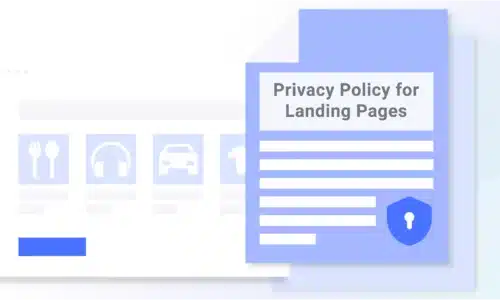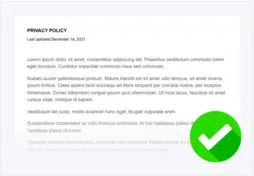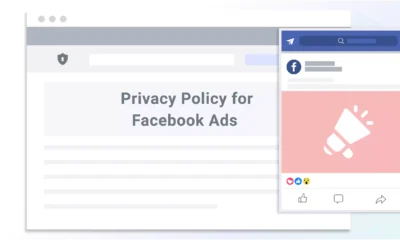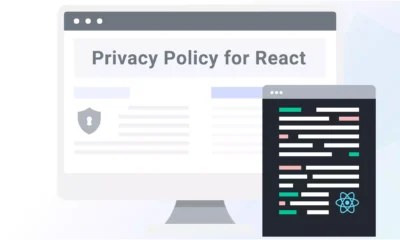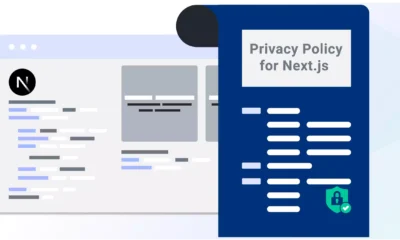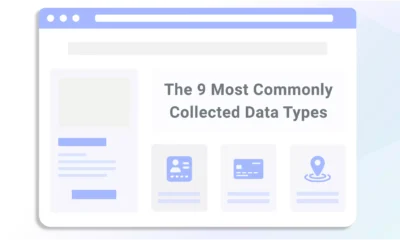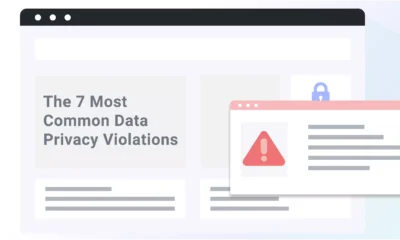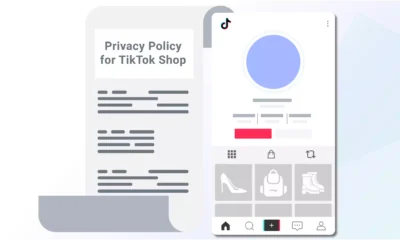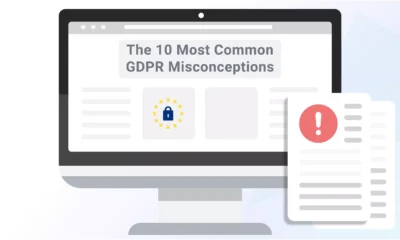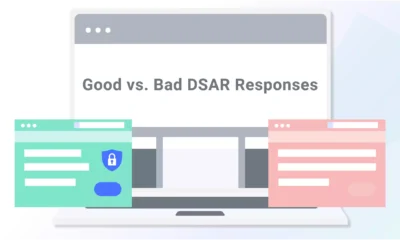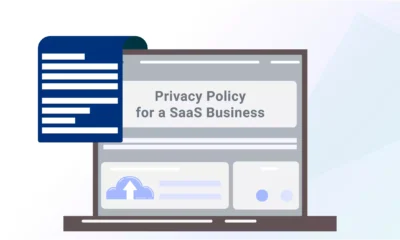Landing pages help turn visitors into leads, which builds out your business’s customer base.
But if your landing page needs a privacy policy if it collects personal information from users, like email addresses, names, and phone numbers.
Below, I explain why landing pages nearly always need a privacy policy, what goes into one, the laws that impact it, and how to easily make one for your business.
How To Make a Landing Page Privacy Policy
You can make a privacy policy for your landing page using a policy generator, a template, or writing it yourself.
Use a Privacy Policy Generator
The simplest way to make a privacy policy is to use a managed solution, like our free Privacy Policy Generator.
Built by our legal team and data privacy experts, it includes information to comply with 26 privacy laws and counting.
It asks basic questions about your business and data collecting practices, then uses your answers to make a unique, comprehensive policy, which takes all the hassles and guesswork out of data privacy compliance.
You can easily embed it directly on your site.
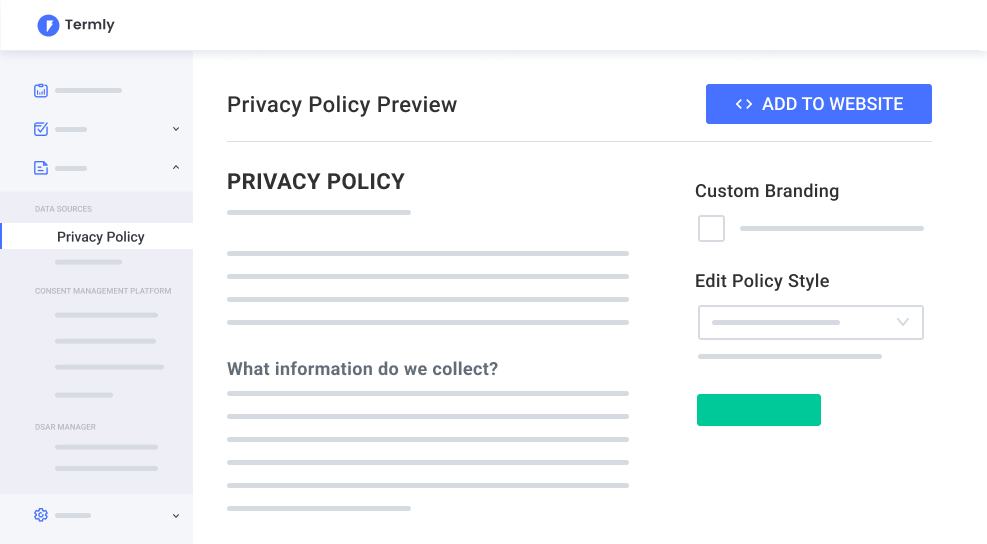
Use a Privacy Policy Template
You can also use Termly’s free privacy policy template, which is properly formatted and features the necessary clauses to comply with several data privacy laws.
To use it, fill in the blank sections of the document with accurate details about your business and remove or add clauses as necessary.
Then, choose which format you want to use when downloading your policy, and embed it directly on your landing page.
Write Your Own Privacy Policy
You can also write your own privacy policy, but this is only recommended if you have extensive legal knowledge, as data privacy laws hold you accountable if you leave anything out.
Ensure whatever you write is thorough, easy to read, comprehensive, and meets all requirements outlined by applicable data protection laws.
To help you through this process, check out our guide on how to write a privacy policy.
Does Your Landing Page Legally Need a Privacy Policy?
Your landing page legally needs a privacy policy if your business falls under any data privacy laws, as these pages often collect personal information from users, such as:
- Names
- Emails
- Phone numbers
- Addresses
Data privacy laws apply depending on your business’s location, users’ location, and monetary and data collection thresholds.
So, if you run your landing page out of New York but collect data on California residents, California’s privacy laws might apply to you.
Some examples of laws that require privacy policies that may impact your business include the:
- General Data Protection Regulation (GDPR)
- California Consumer Privacy Act (CCPA)
- California Online Privacy Protection Act (CalOPPA)
- Colorado Privacy Act (CPA)
- Connecticut Personal Data Privacy and Online Monitoring Act (CTDPA)
- Virginia Consumer Data Protection Act (VCDPA)
As the Owner and CEO of The Laundry Basket LLC., Hyacinth Tucker understands the importance of a strong, trustworthy landing page. “Complying with consumer data privacy laws is both a responsibility and an opportunity for my business,” she says.
“In an industry where personal data, such as contact details, service preferences, and payment information, is collected, our customers need to feel confident that their information is secure,” says Tucker.
“By demonstrating transparency and accountability, we strengthen customer loyalty and enhance our brand reputation.’ — Hyacinth Tucker, Owner & CEO, The Laundry Basket LLC
“One of the biggest challenges we face is navigating the ever-changing privacy landscape while running a fast-growing business. Compliance requires time, resources, and continuous education,” she says.
So how did her business achieve privacy compliance across their landing pages and beyond?
“To overcome this, we use managed privacy compliance solutions and consult legal experts to ensure we stay updated and proactive rather than reactive. Automating data protection processes has also been a huge help in streamlining our compliance efforts.”
What Are Landing Pages and Squeeze Pages?
Landing pages and squeeze pages are where your visitors respond to calls to action, and while they’re similar, they both serve a different purpose.
A squeeze page typically features minimal information, is used to collect contact information from prospective customers (i.e., email addresses), and has a singular focus, like:
- Asking users to sign up for a newsletter
- Downloading an ebook
- Gaining access to exclusive content
A landing page also usually has a singular focus but provides more detailed information to convert users into paying customers rather than simply collecting their contact information.
It provides particulars about a business’s product or services and may feature additional content, including:
- Detailed information about your product or service and what it does
- Testimonials or reviews from real customers
- Features of your product or service that you want to highlight as selling points
- A video showing how to use your product or service
Both typically require a privacy policy if you collect personal information from visitors.
What Is a Privacy Policy?
A privacy policy is a document that informs people about your business’s data collection and processing activities.
It lets webpage visitors know:
- What personal information you collect
- Why you collect that data
- How it gets used and your legal basis for using it
- If you share it with or sell it to any third parties
- What rights they have over their information
- How they can act on those rights
Any information gathered about users on your landing or squeeze page must appear in your privacy policy.
What Are the Benefits of Having a Privacy Policy on Your Landing Pages?
There are several surprising benefits to having a privacy policy linked to your landing page, including the following.
Legal Compliance
Most data privacy laws require businesses to have a privacy policy, so posting one helps you attain legal compliance and avoid fines and penalties.
Transparency
Consumers want to know what you’re doing with their information, and a privacy policy transparently communicates your data processing activities to your users.
Consumer Trust
Establishing trust with your users helps you retain customers, and posting a privacy policy enables you to earn it by showing you take their privacy seriously.
Third-Party Apps
Many third-party apps businesses rely on require privacy policies, so using one helps improve relationships with apps run by entities like Apple or Google.
What Should You Include in Your Landing Page Privacy Policy?
Your privacy policy should include specific clauses featuring details about your data collection and processing activities across your entire site, not just your landing page.
Introduction
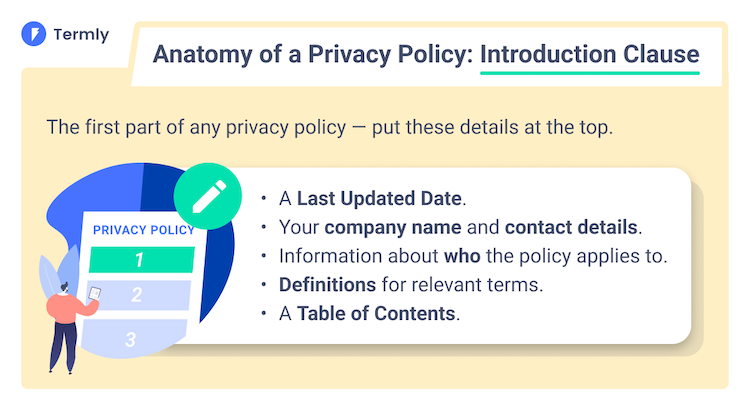
Start your landing page privacy policy by writing a clear introduction section.
It should include your full company name, details about who the policy applies to, definitions for all applicable terms, and lead to a table of contents.
What Personal Data You Collect
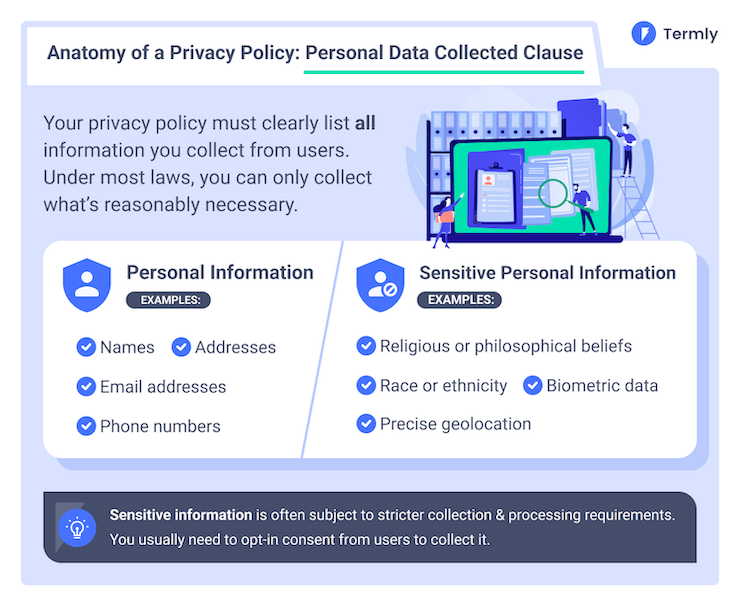
Your privacy policy should clearly explain what personal data you collect from users.
For example, landing pages often track consumers’ email addresses, names, and sometimes even payment information.
Format these details in a bullet list or table to make it easier for people to read and understand.
Remember, you must include the information collected from your landing page and any other parts of your website, including internet cookies or other trackers.
How and Why You Collect the Data
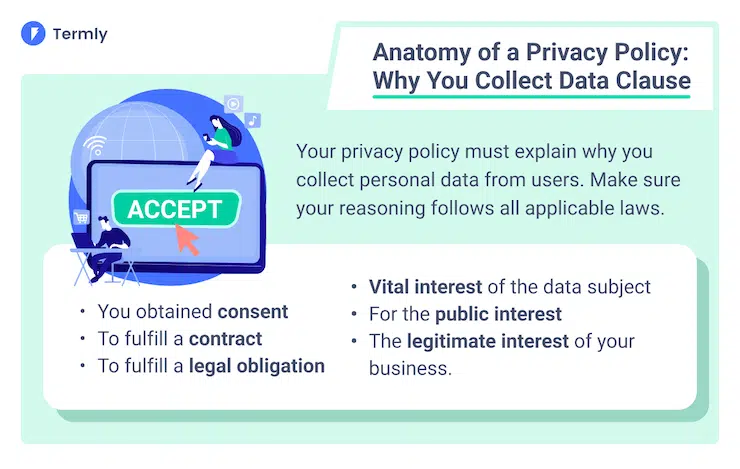
You should clearly explain in your privacy policy why you collect personal data from your webpage visitors, also called your legal basis.
For example, you might:
- Obtain legal consent from individuals to collect the information
- Use their data to fulfill a contract
- Have another legally applicable reason
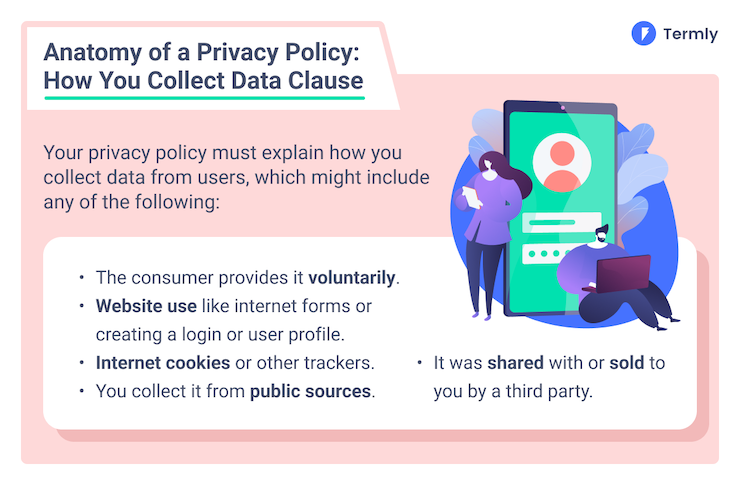
Also explain how you use the personal data you collect from users in your privacy policy.
Let them know if you use it for targeted advertising, marketing and research purposes, product development, or to perform aspects of a contract.
Analyze this section regularly, as the way you use data might change, and if it ever does, you must immediately update your policy.
Note that some privacy laws, like the GDPR, mandate that you must limit your use of personal data to only what is considered necessary and reasonable.
Children’s Data
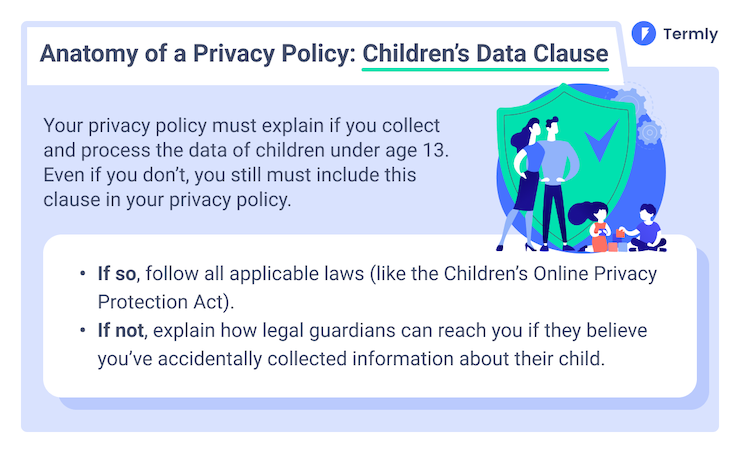
Explain in your privacy policy if your landing page collects any data from known children.
If it does, you’re subject to following additional strict laws, like the Children’s Online Privacy Protection Act (COPPA).
If not, inform parents and legal guardians how they can contact you in case they ever believe you accidentally collected information about their child.
Whether You Share Data With Third Parties
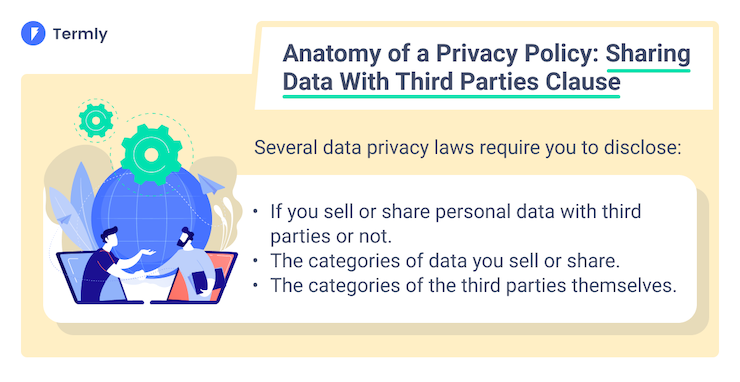
If you share personal information with any third parties, you must say so in your privacy policy, as required by most data privacy laws.
Your Data Retention Policy
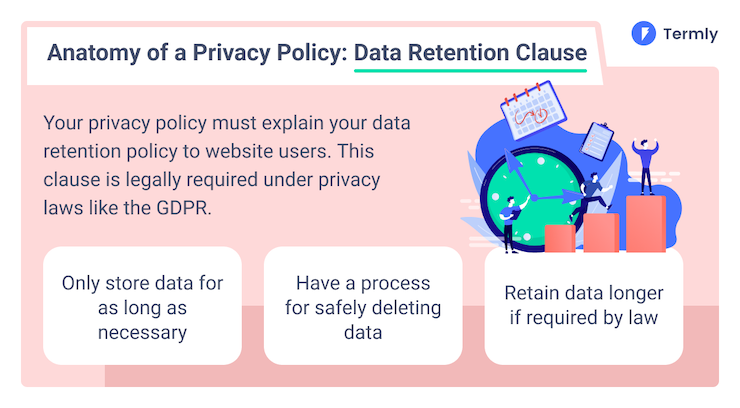
You must explain how long you plan to retain the personal data and how you determine this timeline as a clause in your landing page’s privacy policy.
Under most laws, you can only keep the data for as long as necessary to achieve the purposes for data collection, as disclosed to your users.
How You Protect the Data You Collect
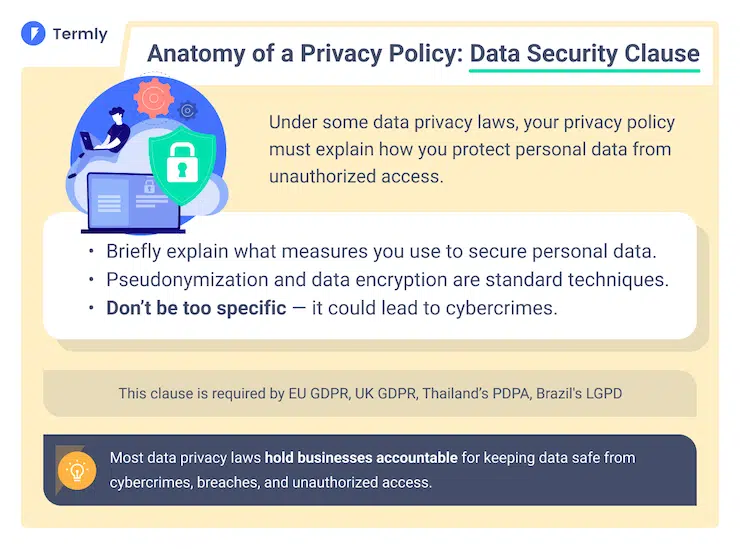
Briefly explain the different safety and security procedures you use to adequately protect personal data from a data breach or unauthorized access.
These measures might include:
- Encryption methods
- Secure storage
- Limited access by internal staff
Most data privacy laws require you to implement reasonable safeguards concerning the personal data you collect and store and hold you accountable if it’s ever compromised.
Whether You Use Cookies or Other Data Tracking Methods
![]() If your landing page or website uses cookies or other tracking technologies, you must inform your users by putting these details in a clause in your privacy policy.
If your landing page or website uses cookies or other tracking technologies, you must inform your users by putting these details in a clause in your privacy policy.
For example, you might use data tracking to determine how your customer arrived at the landing page or where they went after entering their information.
Because cookies collect personal information from users, they fall under the scope of data privacy laws.
You should also indicate whether you participate in data tracking and, if so, for what purpose and have a separate cookie policy.
How Consumers Can Control Their Data
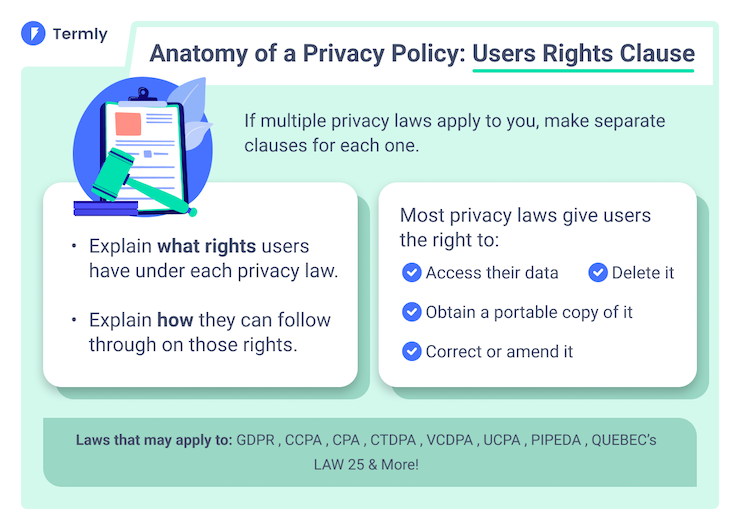
A big part of many privacy laws is providing multiple methods for consumers to follow through on their data privacy rights.
Clearly explain in a clause all rights your users have over their information and how they can act on them.
Your privacy policy should also describe how your company responds to these consumer requests and how users can appeal any of your decisions.
Updates to Your Privacy Policy
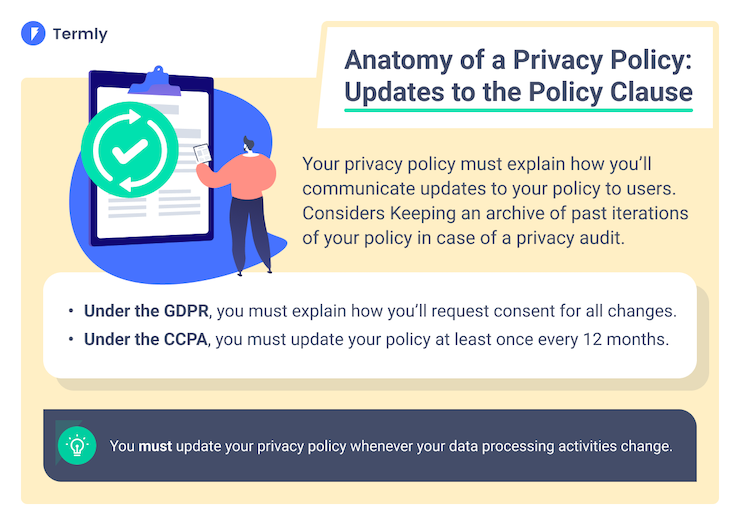
To ensure your privacy policy is always accurate, it should adapt and change whenever your data processing activities do.
You might experience an internal policy change, fall under new data privacy legislation, or add a new landing page to your site focusing on a new product or service offering.
Explain in a clause how you’ll communicate privacy policy changes to consumers, and include a ‘Last Updated’ date somewhere on your current policy.
International Data Transfers

Laws like the GDPR require you to explain if you plan to transfer data internationally and verify that the data will be protected using the same standards outlined by the law.
Your Company Contact Information
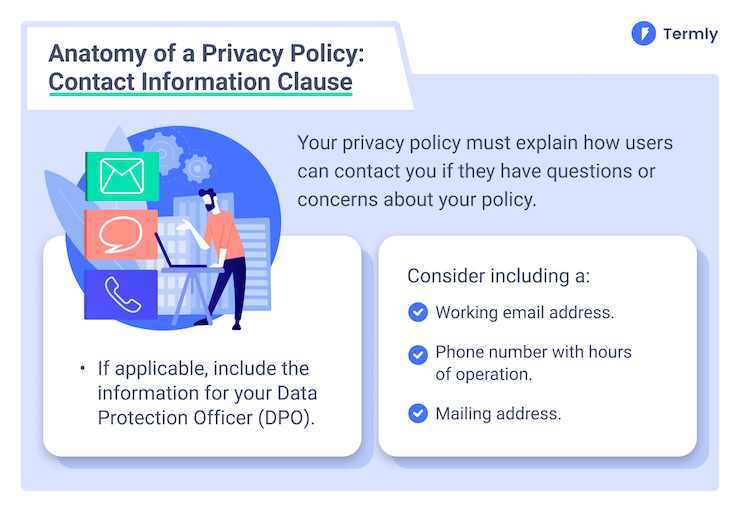
Include a clause in your privacy policy that has working contact information available so your users know how to reach you if they have any comments, questions, or concerns.
Where To Display Your Landing Page’s Privacy Policy
You should put your privacy policy in specific places throughout your site and ensure it’s accessible directly from your landing or squeeze page.
Plan to put a link to it in the following spots:
- Static places visible on all webpages, like your footer
- On any form, especially if you use one on your squeeze or landing page
- Payment screens or new user account creation pages
- In a legal or privacy center on your site
- On a pop-up banner
Your visitors should have no problem locating the hyperlink to your policy and should always be able to click on it easily.
Summary
If your landing page collects personal data from page visitors, you need a privacy policy.
Posting one helps you meet legal requirements and builds essential trust with consumers.
Make it extra easy on your business and use our free Privacy Policy Generator to make a comprehensive, compliant policy no time.

